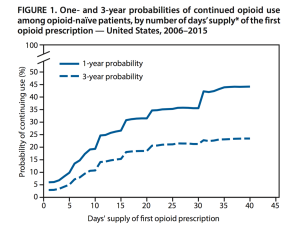.jpg)
The most fundamental rule of medicine is do no harm. Yet in treating pain, some physicians have inadvertently put their patients on the path to addiction. A new Centers for Disease Control and Prevention study reveals how just a handful of opioids can lead people into drug dependence. According to the CDC’s findings, an initial 10-day prescription results in one in five patients becoming long-time users.
PDFNJ has long recognized the need to reign in prescribing practices to help combat the opiate epidemic that has claimed thousands of lives over the last decade (nationally, the CDC estimates 91 people die every day of opiate overdoses). In its work to address the opiate crisis, PDFNJ has enlisted Dr. Andrew Kolodny, Executive Director of Physicians for Responsible Opiate Prescribing, to help convey the message that doctors need to rethink liberal prescribing of opiates. Another essential component in this fight is ensuring that pain treatment receives much more attention in medical school.
Excessive reliance on prescribing opiates for pain is the root cause of the opioid epidemic that New Jersey and other states have encountered over the last decade. The message doctors must absorb is that anything more than a three-day prescription risks a putting a patient in harm’s way; the last thing the practice of medicine should do. NJ recently took a step in this direction with a measure that caps initial opiate prescriptions at five days. PDFNJ is looking to build on this progress with a series of Do No Harm Symposiums, the next two of which are March 30th at Capital Health Medical Center in Pennington for dentists and April 6th at Newton Medical Center for doctors and other prescribers.
from arstechnica.com:
The longer you use opioids, the greater the risks—and the risks rise fast.
The longer a person uses opioids, the greater the risk of forming a deadly addiction. But just how long does it take to switch from being a short-term user—say, while you’re dealing with pain after a surgery—to a long-term, potentially problematic user? A few weeks? A month?
According to a new study, that transition could take just a matter of days.

When patients get an initial opioid prescription that’s just a one-day supply, they have about a six-percent chance of being on opioids for a year or longer. But if that first prescription is for a three-day supply, the probability of long-term use starts inching up. With an initial five-day supply, the chance jumps to about 10 percent. With a six-day supply, the chance hits 12 percent. With 10-day’s worth, the odds of still being on opioids a year later hits roughly 20 percent.
So, with an initial 10-day opioid prescription, about one-in-five patients become long-term users. That’s according to the new study’s lead author Bradley Martin, a professor of pharmaceutical evaluation and policy at the University of Arkansas for Medical Science. It’s a fast rise, Martin said to Ars. “We really didn’t expect that.”
And, according to the rest of the data—published Friday in the Centers for Disease Control and Prevention’s Morbidity and Mortality Weekly Report (MMWR)—things just keep getting worse from there.
To calculate the probabilities, Martin and his colleagues tracked the prescription records of nearly 1.3 million patients. Those patients were all 18 or older, cancer-free, and got at least one opioid prescription between June 2006 and September 2015. They also didn’t have any history of opioid abuse.
For patients who get a 30-day stash of opioid all at once for their initial prescription, the chance of being on opioids for a year rose to 45 percent. But, Martin says, getting that much in one go is uncommon. Only about seven percent of patients get such long-duration prescriptions in the study. Most people get about a week’s worth at a time.
People who got 30 days of opioid total—meaning they may have gotten multiple prescriptions or refills over time—had about a 30-percent probability of using opioids for a year. And they had a nearly 20-percent chance of being on them for three years.
Other factors that kicked up the chances of long-term use were long-acting opioids, getting a cumulative dose equivalent to more than 700 milligrams of morphine, and getting multiple prescriptions. One in seven who got a second opioid or a refill were on the addictive drugs for at least a year.
Martin says he hopes the fresh data will help prescribers make smart and informed choices when doling out the powerful drugs. Early last year, the CDC released guidelines for prescribing opioids, recommending weak, short doses, ideally three days for acute pain. The agency urged doctors to refrain from prescribing opioids for chronic pain, except for cancer patients and end-of-life care.
In the study, Martin and colleagues found that less than one percent of patients were prescribed powerful, long-acting opioids, which are used for chronic pain. This suggests that intentional chronic pain prescriptions are uncommon. But the authors did note that 10 percent of patients got tramadol, which is considered a relatively safe opioid. So this may hint that some intentional prescriptions for chronic pain is going on.
The CDC estimates that 91 people die of an opioid overdose every day in the US.
